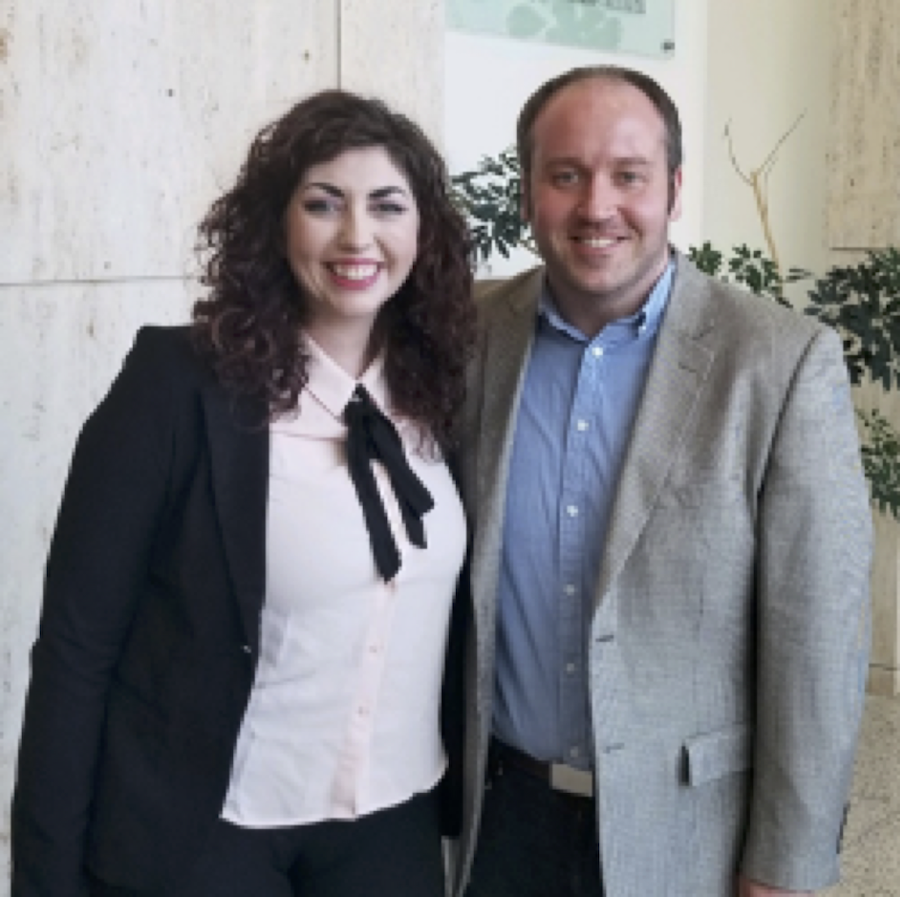An update on Dr. Carly Hanson, a recent PhD graduate from Jim Devery's group.

(left) Carly Hanson with her PhD advisor, Jim Devery (right)
Carly Hanson entered Loyola’s graduate program in Chemistry in the Fall of 2015, with the goal of pursuing a career in cosmetic chemistry. As a massive fan of makeup art in fashion and in movies, she wanted to pursue this passion with the depth of understanding a PhD in chemistry provides. Specifically, she was interested in understanding the physical interactions of molecules. With that in mind, she joined Jim Devery’s lab.
While Dr. Devery’s lab, Carly studied the mechanism of carbonyl-olefin metathesis, which is in collaboration with the Schindler and Zimmerman labs at the University of Michigan. Olefin metathesis represents one of the most important synthetic developments, impacting the production of high value small molecules, natural products, and materials. However, the limitations of this transformation include a requirement for high catalyst loadings of precious metals and the fact that the olefin-containing substrates are often prepared inefficiently from simple carbonyl-containing compounds. The Schindler lab developed a method for carbonyl-olefin metathesis using inexpensive and abundant FeCl3 as the catalyst. The Zimmerman lab has performed computational analysis on this transformation and proposed a catalytic cycle involving a turnover-limiting, asynchronous, concerted [2+2]-cycloaddition, followed by fragmentation to the product.
Carly began her examination of carbonyl-olefin metathesis with the “simple” task of measuring a single equilibrium constant. What actually happened turned into a multi-year project. In the course of trying to accomplish this “simple” task, she developed a new methodology for examining the solution interactions of Lewis acids and carbonyls. Carly successfully combined simple titrations via in situ-IR spectroscopy to great success. This resulted in a video paper in the Journal of Visualized Experiments. This video publication is available so that other chemists can effectively employ her technique to characterize their own systems.
After developing this effective approach of examining the ground state solution behavior of Lewis acids and carbonyls, she employed her analytical method towards the examination of Lewis acids that are routinely used to mediate reactions of carbonyls. She examined systems that employed ZnCl2, AgOTf, I2, CeCl3, BCl3, BF3, InCl3, ZrCl4, GaCl3, FeCl3, AlCl3, TiCl4, and SnCl4. Her method allowed for the observation of a diverse array of interactions, including no interaction as well as mono-, di-, tri-, and even tetrameric complexation of simple carbonyl compounds to the examined Lewis acids. Additionally, not only was she able to observe these structures, but she was able to specify under what conditions the species form. On this project, Carly mentored three undergraduate researchers that employed her method to great success. As of result of her efforts, this work was published in The Journal of Organic Chemistry with Carly as the first author (https://pubs.acs.org/doi/10.1021/acs.joc.9b02822).
The culmination of Carly’s efforts, however, is best expressed in her examination of catalyst behavior in carbonyl-olefin metathesis. Using her titration method, she examined the disparate solution behavior of FeCl3 and GaCl3. In the process of examining the solution interactions of these Lewis acids, Carly observed vastly different interactions of Ga(III) and carbonyl compounds and Fe(III) and the same compounds. For Ga(III), she found that only simple Lewis pairs resulted and that the solution behavior was consistent with classical Lewis acid/base interactions. Fe(III) yielded some of the most complex solution spectra I have ever seen. Carly was able to take these data and determine the concentration-dependent behavior of these species, finding that the classical Lewis acid/base mechanism only applies under stoichiometric conditions and is simply incorrect when considering certain catalytic reactions. She was able to develop corroborating experiments using solution conductivity to determine that carbonyls are capable of ionizing FeCl3 and dramatically changing its catalytic activity. Most importantly, she was able to develop a model that explained the observed reactivity in recalcitrant carbonyl-olefin metathesis systems. This effort is a massive tour-de-force of physical organic chemistry performed with a high level of rigor. On top of her research effort, she also led a team of undergraduates to obtain exceptional data. This amazing work resulted in a first author paper for Carly in the Journal of the American Chemical Society(https://pubs.acs.org/doi/abs/10.1021/jacs.9b02613).
Carly was the first place winner for best poster at the Society of Cosmetic Chemists Midwest Chapter Fall Technical Symposium that was held on October 8th, 2019. As the winner, she received a paid trip and a chance to present her work at the Society of Cosmetic Chemists 73rd Annual Scientific Meeting & Technology Showcase. The Society of Cosmetic Chemists strives to increase and disseminate scientific advancements in cosmetic science through meetings and publications. By promoting research in cosmetic science and industry, and by setting high ethical, professional and educational standards, we improve the qualifications and caliber of cosmetic scientists. Carly presented her research at multiple National ACS Meetings, the 2019 Heterocyclic Compounds Conference of the GRC, and the Chicago Organic Symposium. She was invited to give a seminar at Valparaiso University.
Dr. Carly Hanson completed her PhD in the Spring of 2020. This summer, she started a postdoc in the lab of Prof. Derek Pratt in the Department of Chemistry and Biological Sciences at The University of Ottawa. Prof. Pratt's lab specializes in mechanistic organic chemistry research, where they examine the mechanisms of lipid oxidation, natural product antioxidants, fossil fuel stability, and free radical chemistry.
We’re very excited to see what Dr. Hanson will publish next!
